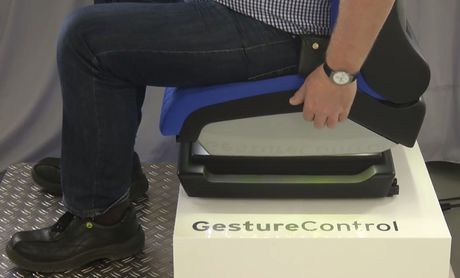Smart driver seat that responds to gestures

It’s now often said that sitting is the new ‘smoking’ — a bad habit harmful to our health. Many professions require people to sit for long periods throughout the day, such as office workers or truck drivers. Professional drivers in particular can spend an average of nine hours a day sitting in their vehicle cabin with little movement and, as a result, can be prone to back problems.
According to the Fraunhofer Institute for Silicate Research (ISC), studies conducted by a statutory health insurance company demonstrated that a driver’s seat adjusted properly to the person at the wheel, in terms of shape and position, can be an effective countermeasure to back pain. While many manufacturers provide a selection of seat position options, drivers tend to only use them occasionally as they can be complicated to operate.
Researchers at the Fraunhofer ISC, however, in collaboration with Isringhausen GmbH & Co. KG., have engineered a driver’s seat that can be calibrated intuitively by simple hand gestures through sensors, which it is hoped will counter these drawbacks.
“With the aid of simple hand gestures, the driver can move the seat forward and back, as well as up and down. In addition, he or she can also custom-set the incline of the thigh support and backrest in the same manner,” said Johannes Ehrlich from the Center for Smart Materials (CeSMa) at Fraunhofer ISC.
The scientists working on the project have integrated sensors including piezosensors, which respond to pressure, into the synthetic side cover so that the seat reacts to the driver’s hand motions. To ensure the motion-controlled system is activated, the driver lightly presses a certain point on the side cover, which prevents the motion control from being accidentally triggered, said Ehrlich. Seat positions can also be stored, a feature designed for when multiple drivers need to use the same vehicle.
Proximity sensors built into the side cover are also used to detect gestures and can track the smallest changes in electrical fields, such as those triggered through hand motions. A software program engineered at ISC reads these sensors and determines the hand’s direction of motion from this. An intelligent algorithm in the software guarantees that multiple electrodes can be evaluated simultaneously, thereby reducing incorrect operation.
“We have attached electrodes to the relatively limited space so that the necessary control gestures are easy and ergonomically favourable,” said Ehrlich.
In order to set the seat position, the driver performs brief hand motions along the entire side cover — similar to the ‘brushing’ motion on a touchscreen. Depending on the directional motion of the gesture (up/down, forward/back or diagonal), the individual seat elements are adjusted accordingly. Once the driver has performed the settings, the gesture control automatically shuts off when the hand moves away from the sensor area. The driver then receives confirmation that the gestures were stored successfully through an LED instrument.
A fully functional prototype of the sensor seat is now available and is anticipated will soon be available to the automotive market.
Contract labour in mining: do savings outweigh safety outcomes?
Australian researchers have analysed decades of research on contract labour in mining, arguing...
Psychosocial risk management: eight trends with tips
Psychosocial risk management has become a central pillar of workplace safety and organisational...
50 in 2024: Victoria's workplace fatalities figures
Transport, construction and agriculture were Victoria's deadliest sectors in 2024, with...










